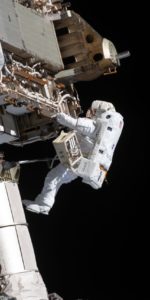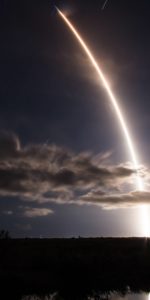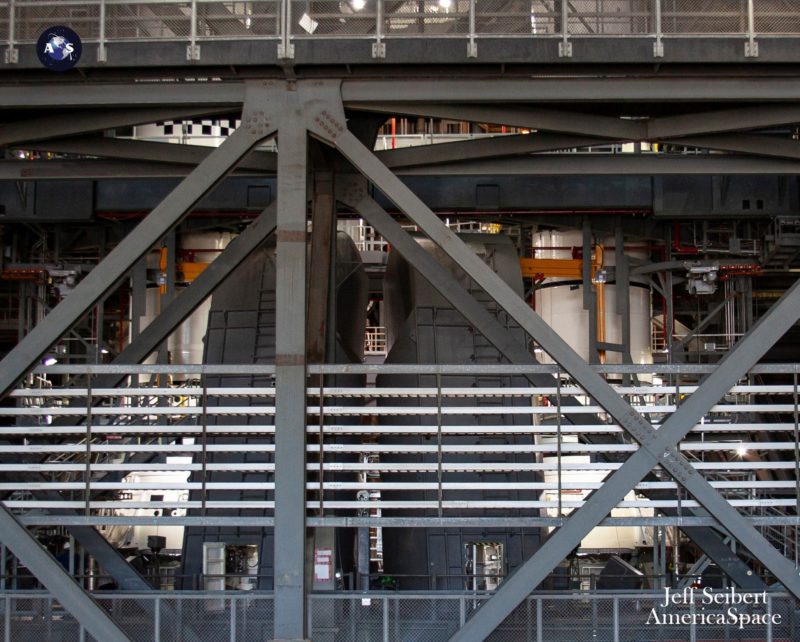
Following last month’s brief ignition of four shuttle-era RS-25 engines at the base of the Core Stage for the first Space Launch System (SLS), NASA has announced that it will execute a second Hot Fire Test as soon as the week commencing Sunday, 21 February. The 212-foot-tall (64.6-meter) Core Stage has for more than a year resided in the B-2 Test Stand at NASA’s Stennis Space Center (SSC) in Bay St. Louis, Miss., where it is being put through an extensive, eight-step “Green Run” campaign to ensure its functional and operational readiness for launch.
In the meantime, inside the cavernous expanse of the Vehicle Assembly Building (VAB) at the Kennedy Space Center (KSC) in Florida, stacking of the twin five-segment Solid Rocket Boosters (SRBs) is nearing completion.
Following its arrival in the B-2 Test Stand early last year, the Core Stage was put through a punishing regime of five functional tests between January and September. These were accomplished with remarkable speed in view of the worldwide march of the COVID-19 coronavirus pandemic and multiple natural predators in the form of Hurricanes Marco, Laura and Sally last summer and Hurricane Zeta last fall.
This work validated models to operate the giant rocket’s Guidance, Navigation and Control (GNC) systems, checked out its avionics, tested its safety systems, evaluated command control operations for its Main Propulsion System (MPS) and operated its Thrust Vector Control (TVC) and hydraulics.
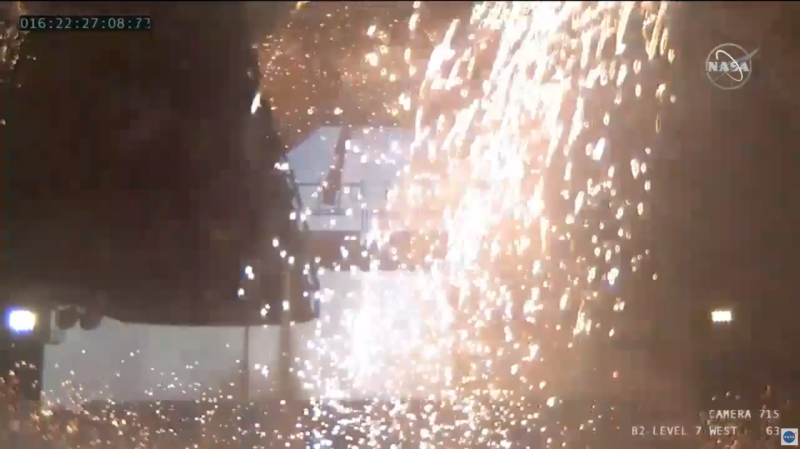
Following the completion of the functional tests, three operational tests got underway in October, simulating a full SLS countdown, loading more than 733,000 gallons (3.3 million liters) of liquid oxygen and hydrogen propellants into the Core Stage—known as the Wet Dress Rehearsal (WDR)—and test-firing the four RS-25 engines for a full mission duration of over eight minutes. This “Hot Fire Test” finally got underway on 16 January, but was cut short and the engines commanded to shut down after only 67.2 seconds.
It was later revealed by NASA that the premature shutdown was triggered when one engine exceeded its highly conservative test parameters. Original plans called for the quartet of engines—all of which are refurbished Space Shuttle Main Engines (SSMEs), with over 1.1 million seconds’ worth of “burn-time” and a total of 25 shuttle missions to their credit—to be fired for up to 485 seconds, approximating as closely as possible the conditions that they will encounter during the SLS rocket’s raging climb to orbit.
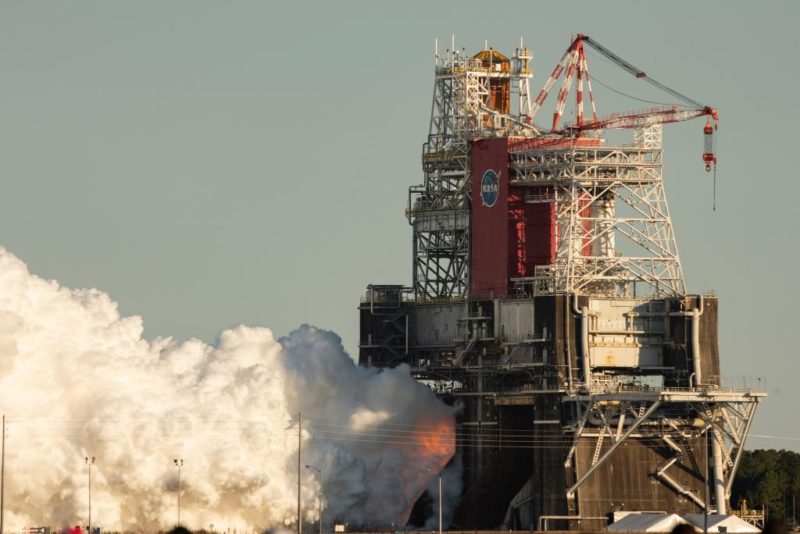
A minute into the Hot Fire Test, the pre-planned gimbaling of the engines under TVC control got underway. “We began to go through an aggressive gimbal profile of all four engines,” explained SLS Program Manager John Honeycutt of NASA’s Marshall Space Flight Center (MSFC) in Huntsville, Ala. Responsibility for gimbaling the engines fell to the TVC actuators, each of which is powered by a Core Stage Auxiliary Power Unit (CAPU).
At about 61 seconds into the Hot Fire Test, CAPU-2—which serves the Core Stages’ No. 2 engine—detected low hydraulic fluid levels and after a series of verification checks over the next two or three milliseconds to validate the reading, properly shut itself down. The other three CAPUs momentarily increased their hydraulic pressures to 105 percent to compensate for the evolving situation, before CAPU-2 commanded the Core Stage flight computer to shut down the other engines. This was executed safely and satisfactorily.
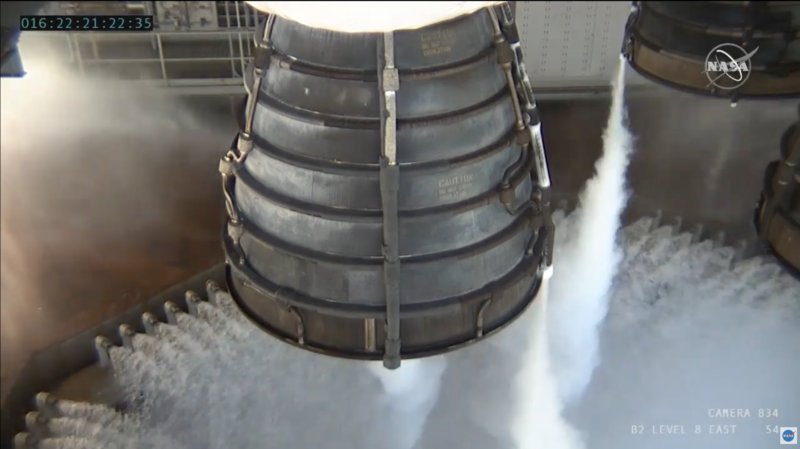
In summing up the behavior of Core Stage systems during the test, NASA noted that on a “real” launch the CAPU margins would have been loosened and CAPU-2 would have continued to function normally. It was stressed by Mr. Honeycutt that parameters were intentionally set at highly conservative levels to best protect the Core Stage, which is, of course, not simply a test article, but actual flight hardware.
The Hot Fire Test was intended to acquire test data in support of 23 detailed verification objectives, with the 16 January firing having “met the goals for a number” of these requirements, “such as those related to activities prior to engine ignition”, and having “partially met the goals for several additional” objectives. Five significant successes included transitioning to the automated launch sequence (operated by the Core Stage flight computer and Green Run software), completing the terminal countdown sequence, pressurizing the propellant tanks, firing the four RS-25 engines at a 109-percent power level and operating the TVC system for effective steering capability.
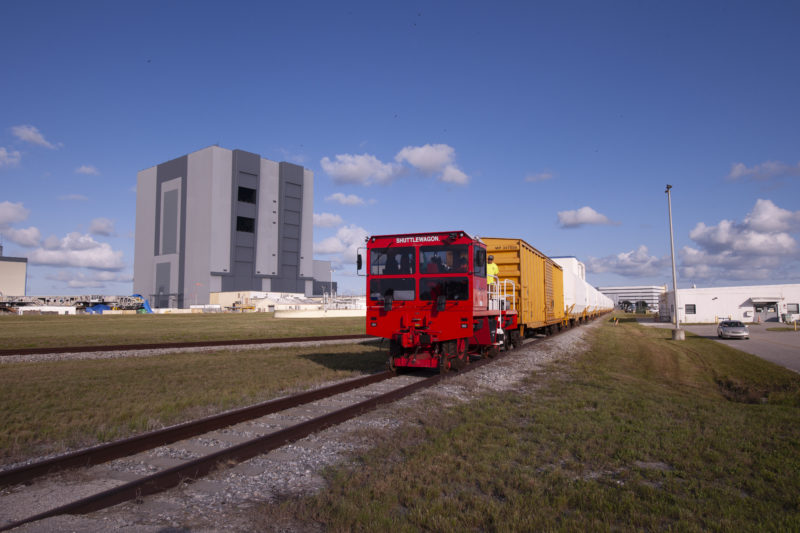
“They are looking at the test data to determine if the parameters need to be changed,” NASA’s Tracy McMahan told AmericaSpace. “It is really the way the parameters triggered the shutdown by the flight computers that is also being evaluated. Basically, the flight software is programmed that if these two parameters go beyond these redlines, it shuts down the test. This is the control logic of the software. It is fairly easy to adjust this because of the way the software is written. They will not adjust the parameters beyond what they think is the right amount to still protect the stage and the engine. They learned a lot about how the stage operates during the first hot fire that they did not know before the first hot fire; this data is helping them determine how to set those parameters, so they still protect the core stage.”
It was also noted that the Core Stage can be loaded with propellant and pressurized a total of 22 times, with two “cryogenic loading cycles” having been completed thus far: last fall’s WDR and the first Hot Fire Test. “Before Green Run testing began, SLS had allocated nine cryogenic cycles for testing at NASA’s Stennis Space Center,” the agency explained, “and has used two of those during the Hot Fire and Wet Dress Rehearsal, with seven cryogenic cycles remaining for additional testing.”
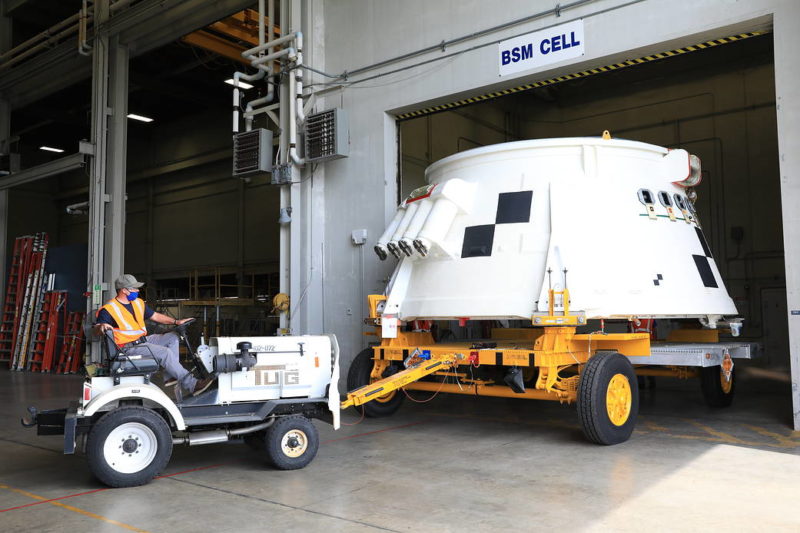
The remaining 13 cryogenic cycles are being held in reserve for the Core Stage’s role in the ambitious Artemis-1 mission, to guard against the possibility of multiple fueling campaigns in support of multiple launch attempts, as well as a pre-launch WDR “and other activities that require propellant loading and tank pressurization”.
Just last week, NASA and Core Stage prime contractor Boeing announced their intent to conduct a second Hot Fire Test “as early as the fourth week in February”, revealing that doing so “would pose minimal risk” to the hardware, whilst yielding valuable certification data ahead of Artemis-1.
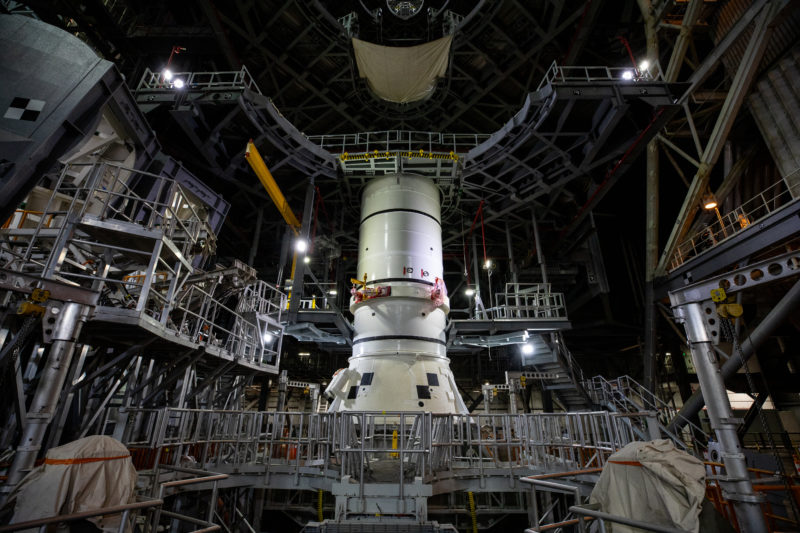
“Conducting a second Hot Fire Test will allow the team to repeat operations from the first Hot Fire Test and obtain data on how the Core Stage and the engines perform over a longer period that simulates more activities during the rocket’s launch and ascent,” it was explained. Preparations for the second test including drying and refurbishing the RS-25 engines, tending to minor Thermal Protection System (TPS) repairs and updating conservative control logic parameters on the flight computer.
“These RS-25 engines flew on several shuttle flights and they are designed to be fired more than once,” NASA’s Tracy McMahan told AmericaSpace. “After every firing, they are completely dried with nitrogen. This ensures they are clean and contaminant-free. There are several other things have have to occur, including minor Thermal Protection System repairs. They are also looking at the parameters, such as the ones that triggered the early shutdown, and seeing if the data shows those can be less conservative for the second test. Then they have to update the Green Run Application Software with the new parameters.
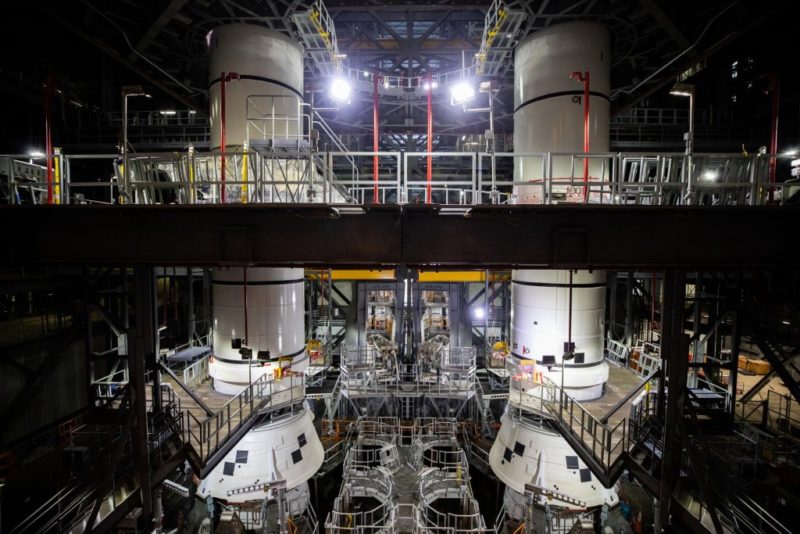
“They will be working all these activities in preparation for the second hot fire. They will know more after a Test Readiness Review that should occur next week. We will try to have another media telecon after that to discuss what they are doing and the path forward.”
In the meantime, the second major component for Artemis-1—a pair of five-segment Solid Rocket Boosters (SRBs), built by Northrop Grumman Corp.—were delivered from Promontory, Utah, to KSC, last June for processing. In readiness for stacking, the boosters’ massive aft “skirts” were moved from the test cell in KSC’s Booster Fabrication Facility (BFF) to the Rotation, Processing and Surge Facility (RPSF) for temporary storage.
Actual stacking preparations got underway in relatively short order, with the initial “pinning” of the aft skirts onto the boosters’ aft segments. Late last November, the aft-segment hardware was transferred from the RPSF to High Bay 3 of the cavernous VAB and in January the center-aft segments were installed atop them. Yesterday, on the anniversary of the loss of shuttle Columbia and her STS-107 crew, NASA announced that the center segments had also been stacked, as booster assembly passed the halfway point.
With the second Hot Fire Test targeted for no sooner than the week of 21 February, the pieces of SLS hardware for Artemis-1 are expected to fall into place later this spring. Assuming that all goes well—and notwithstanding a month-long delay—NASA anticipates the delivery of the Core Stage to KSC in March, but it remains to be seen what long-term impacts this delivery schedule might have on the targeted November launch date. “There are many other activities that affect the launch date,” Ms. McMahan explained. “We will be looking at those activities and trying to gain some efficiencies to protect the launch date.”
FOLLOW AmericaSpace on Facebook and Twitter!
Missions » SLS » Artemis »



